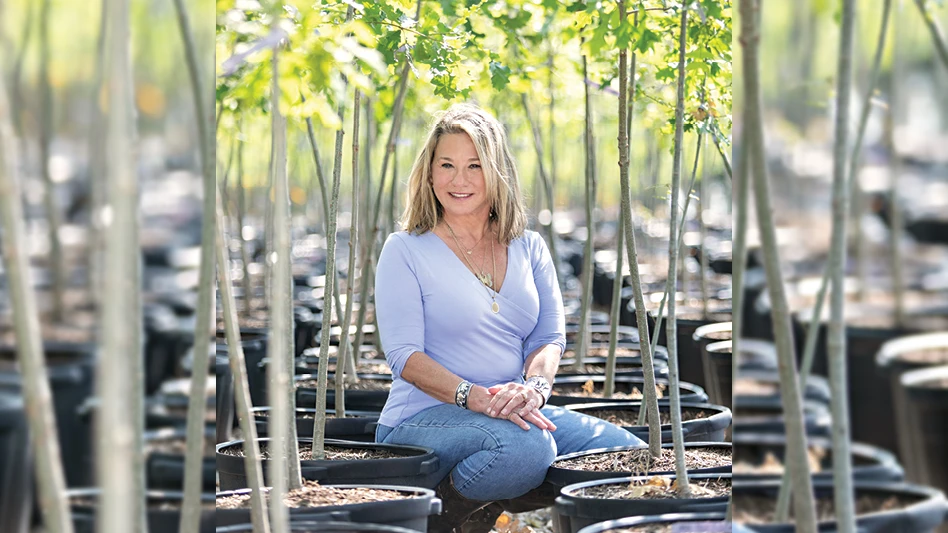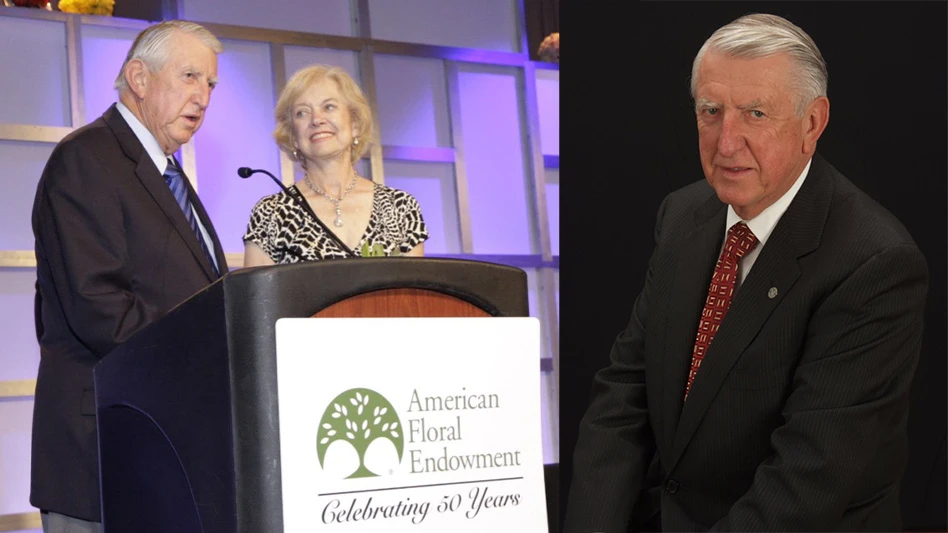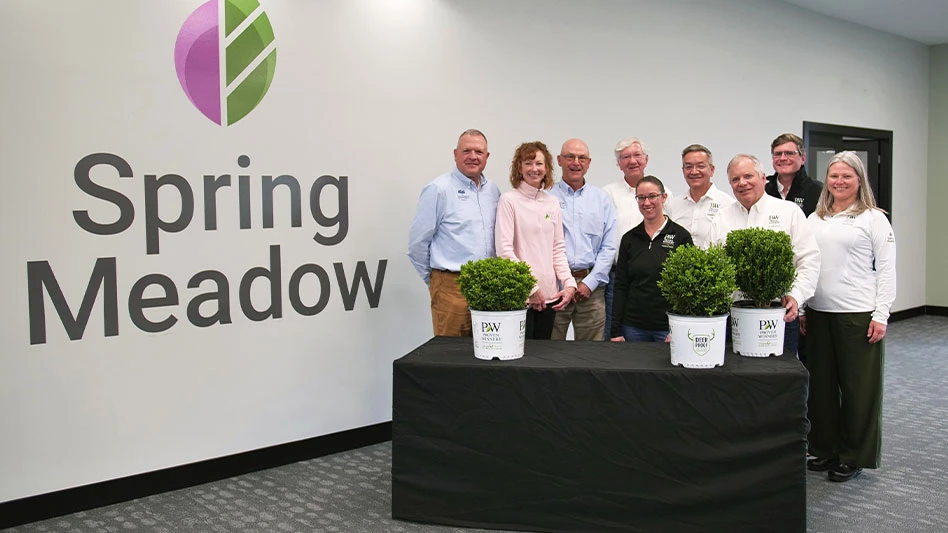
Photos: Forrest Keeling Nursery
With the increase in consumer preference for in-person community interactions and a heightened interest in gardening with native plants, the urban environment is shifting, and The Giving Grove is one nonprofit leading this shift.
The Giving Grove works to increase access to sustainable fresh food through community orchards and food forests programs across the United States that create opportunities for local communities, schools, faith groups, social service agencies and neighborhood groups to grow their own food using fruit trees, nut trees and brambleberries.
Growing trees for community orchards and food forests
Several wholesale growers supply The Giving Grove with fruit trees, nut trees and brambleberries, along with pollinator plants and understory cover crops. The nonprofit has a network of nurseries and suppliers across the country that provide the organization with either discounted products or sometimes donated products to be used in its programs.
The Giving Grove currently has programs in 16 different markets across the U.S. — spanning from Dallas, Texas, to Maine, and from Atlanta, Georgia, to Seattle, Washington. The organization is working across USDA Zones 5-8 and is always looking to partner with new growers. Those partnerships play a vital role in its mission to increase access to sustainable fresh food. The organization looks for specific plant material that can survive in urban environments which may not have ideal soil or growing conditions and are disease and pest resistant.
“It’s really interesting to be able to see what can grow in these different cities, and we’re able to continually add new varieties as new cities come online that have different climates and capabilities,” says Erica Kratofil, co-executive director of The Giving Grove.
Across The Giving Grove’s programs, the organization focuses on biological and holistic approaches to growing, and its team believes this approach is simpler and safer for the communities where these plants are growing.
Forrest Keeling Nursery, located in Missouri, has been supplying The Giving Grove with plants through sales and donations for several years. As a supporting vendor, the nursery has sponsored The Giving Grove’s conferences and supports other affiliates such as Seed St. Louis, and The Giving Grove purchases persimmons, pawpaws, chestnuts, walnuts, pecans and elderberry trees from the nursery — any crop producing edibles that are low maintenance.



Root Production Method
For over 20 years, Forrest Keeling Nursery has grown its plants using a patented growing process called RPM, which stands for Root Production Method. Wayne Lovelace, owner and CEO of Forrest Keeling Nursery, developed this method, and at 89 years old, he is still very active in the business and at the nursey every day.
“He was looking for a way to improve the transplant success rate, in oaks in particular and in wetland plantings,” says Kim Lovelace-Hainsfurther, president of Forest Keeling Nursery. “There are 12 steps in the RPM process, and that guarantees us a quality product and a quality root system.”
The RPM process begins with seed selection. Following germination, the seedlings are exposed to multiple air root pruning at specific depths in a proprietary growing substrate. The substrate is inoculated with mycorrhizae and other beneficial soil microbes. Then the seedlings are transplanted three times based on the proper timing of the root development.
The team at Forrest Keeling Nursery travel to different parts of the country to collect seeds, and the seedlings are coded by region to ensure the best performance and consistent flowering and fruiting in their final planting sites.
“We get 95-98% survival on outplantings where our customers plant a restoration job and walk away from it,” Kim says. “It doesn’t get water or care. It gets nothing but the superior root system that we’re providing with the RPM system, and those plants are surviving and providing ecosystem benefits.”



Don’t be afraid to make a decision
Growing up at the nursery, Kim always wanted to follow in her dad’s (Wayne Lovelace) footsteps. She decided to major in horticulture at the University of Missouri (MU) and spent her first several years in sales at Forrest Keeling Nursery. Then she worked for Armstrong Growers and Stark Bro’s before returning to the nursery in 2004.
In 2013, Kim tragically lost her daughter, Jillian Young, after a car accident. She was 17 years old. Losing her daughter was the biggest challenge Kim faced.
“It taught me that life is precious,” Kim says. “Time is precious, and there are certain things that you can’t fix in life, you have to endure. … I started riding my bike after I lost Jillian. It was very healing for me to get on the bike and ride. It was a time when I could reflect and spend time thinking about her,”
The Jillian Young Foundation has given out over $80,000 in scholarships since Jillian’s death, and the Jillian oak was named in honor of her. Quercus x ‘Jillian Anne Young’ is one of Kim’s favorite native oak cultivars, and it was one of the white oak species selected for the MU Legacy Oaks project. Four Jillian oak trees were planted in her honor on the Francis Quadrangle of the MU campus, and another one was planted at the state capital.
“It’s a challenge trying to channel something so devastating and make it something manageable in your life and something to honor her life by,” Kim says. “Because as painful and horrible as it was to lose her, I would not change one second of the time I had with her. It makes even the pain of losing her worth it. It was wonderful to have her for 17 and a half years as a daughter.”
Kim became president of the nursery in 2020, and she believes in leaving everything better than she found it. The nursery’s mission statement is “restoring the Earth’s ecosystems one tree at a time,” and her desire is to leave the business and the environment in a better position.
“Sometimes you’re not sure which direction to go and afraid of making a decision, or afraid of making a wrong decision, and sometimes that can stagnate you,” Kim says. “Dad is just a wealth of knowledge and one of the best things he taught me was when he told me, ‘Kim, don’t be afraid to make a decision because you can always make another decision’ — that stuck with me. I’m a ‘get it done’ kind of person, so I can pull the trigger on things pretty fast. I think a lot of that is because I know if for some reason it’s the wrong trigger or the wrong thing, you just make a correction and make another decision.”
Forrest Keeling Nursery specializes in native plants, offering 380 different species — 273 trees and shrubs species and 107 perennials. The nursery ships from Missouri to the East coast, into Texas, Oklahoma, Colorado, Nebraska and throughout the Midwest. As a native plant grower, the nursery’s customers are government agencies, mitigation banks, nonprofits and not-for-profits. The nursery participates in conservation, restoration and wetlands projects.
Forrest Keeling Nursery was founded in 1948, and it has always managed to stay relevant. When employees come to Kim with ideas, she is always open and listening — making sure they know that their ideas are appreciated. Then she integrates a lot of those ideas into the nursery plan.
“You can’t [stay relevant] without change, and at times it’s very significant change,” Kim says. “We’re constantly looking ahead and looking for ways to do things differently or asking ourselves, is there a better way? Is there a more efficient way? So, change is something that we see quite often here, and I embrace it. I look forward to what’s coming down the pike and what’s going to be next.”
Kim is proud of the nursery, the team and the impact that they have on the industry and the environment.



Restoring the Earth’s ecosystems one tree at a time
Forrest Keeling Nursery is primarily a container operation, growing 3-gallon to 15-gallon plant material. It also grows a mixture of tree and shrub bare root one-year seedlings in the field. The nursery primarily grows 3-gallon plant material because it does so much work with conservation and restoration. Most of the 15-gallon plant material is used for parks, urban forestry and municipalities.
There are several organizations with projects that line up with Forrest Keeling Nursery’s production and mission, so the nursery also supports The Nature Conservancy and Ducks Unlimited (DU). Both organizations are dedicated to conservation, with DU focusing specifically on conserving, restoring and managing wetlands and associated habitats for waterfowl.
Known for its trees and shrubs, the nursery grows 32 different species of oaks and a line of specialty crops that include nut and fruit producing species such as persimmons, pecans, chestnuts, walnuts and 17 cultivars of pawpaws.
Forrest Keeling Nursery made the decision to eliminate exotic and invasive plants from its production and focus only on native plants to stay relevant in an industry that’s constantly evolving and to have a positive impact on the environment and people.
“We’re always looking for new cultivars, especially edibles, for the specialty crop program,” Kim says. “We just added a black walnut to our offering, and we have two new pecans coming on that the USDA is releasing. So, it just depends on what’s out there in the pipeline.”
Forrest Keeling Nursery is the fourth nursery in the country to become SANC certified, a Systems Approach to Nursery Certification. SANC is a best practices approach to mitigating risk of introducing pests and diseases.


“We identified our critical control points of where a pest or disease might be introduced into the nursery system and have taken steps to mitigate those risks,” Kim says.
The nursery eliminated neonicotinoids from its production around 10 years ago and has an Integrated Pest Management (IPM) program. Every employee is a scout and is trained on the SANC principles and methods of mitigating those risks.
“Natives are more resilient and less prone to certain diseases and pests,” Kim says. “Combining that with our SANC system and our use of biobased pesticides, we have a pretty light footprint in the pesticide side of management. Because of our soil health and our treatment of our soil, we produce healthy, vigorous plants that are less susceptible to pest pressure.”
The Giving Grove has more than 650 community orchard and food forest sites in its network across several growing zones. Each of these sites grow different crops based on the community’s need and climate.
“We’re looking for a little bit of a niche product, so having these relationships with growers and with nurseries that specialize in [food crops] enables us to have a supply chain that serves our programs across the country,” Kratofil says. … “We also really want to be able to offer the community the plant material that’s culturally relevant to them or is of interest to their community. We want to have a wide variety of cultivars that the community can choose from so that they can get the food that makes the most sense for their neighborhood.”
Together, The Giving Grove and Forrest Keeling Nursery are shifting the urban environment one tree at a time. By providing native plants that are surviving tough situations and outplantings, community orchards and food forests are thriving across the country.

Explore the April 2025 Issue
Check out more from this issue and find your next story to read.
Latest from Nursery Management
- The HC Companies, Classic Home & Garden merge as Growscape
- Terra Nova releases new echinacea variety, 'Fringe Festival'
- Eason Horticultural Resources will now officially be known as EHR
- BioWorks receives EPA approval for new biological insecticide for thrips, aphids, whiteflies
- Ellen Mackenbach-Lakeman appointed new CEO of Dümmen Orange
- The Growth Industry Episode 3: Across the Pond with Neville Stein
- Southern Garden Tour sets 2025 dates for trial garden open houses
- New book explores plants that thrive in Rocky Mountains




